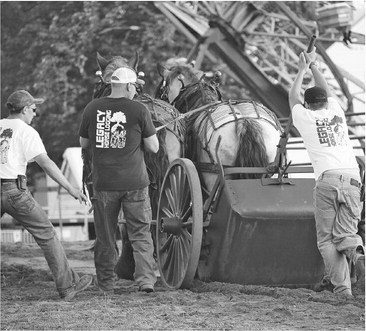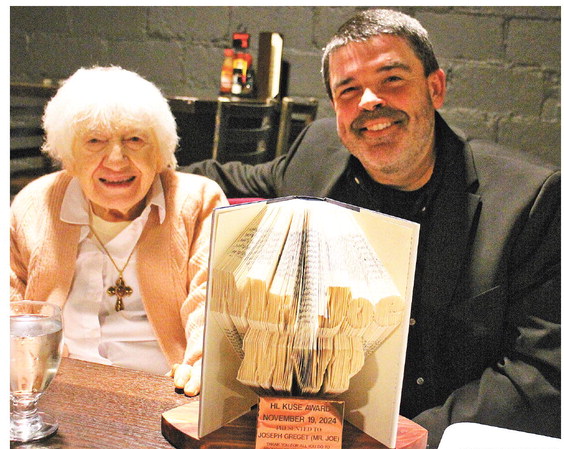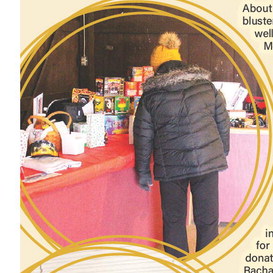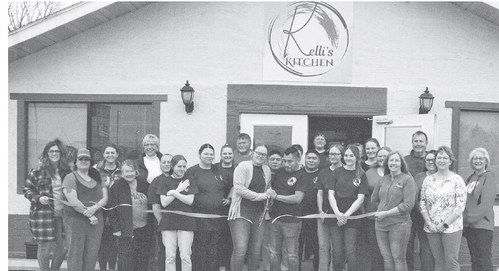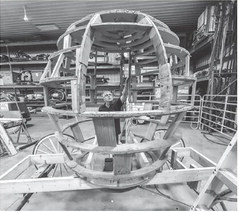Like the old days Taylor County residents restore and exhibit early 1900s slusher
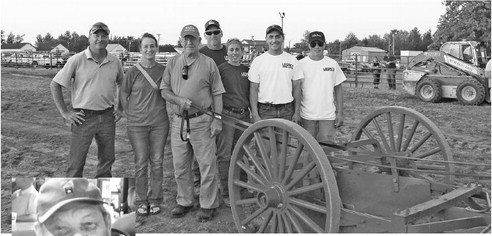

“It was too good to not try to fix,” said Pat Tlusty of Westboro.
Over the course of five years, Tlusty restored a horsedrawn slusher, a machine used to make dirt paths for railroads in the early 1900s, with the help of Mike Chaplinski of Gilman and Rudy Jaeger of Gilman.
The restoration journey started when Tlusty was exploring a piece of property he had recently purchased in Westboro. He chanced upon a piece of machinery entangled in brush next to an old railroad right-of-way. “I didn’t know what it was at first. It was just a big scoop deal and one wheel was off of it,” he said.
Tlusty called his friends, Chaplinski and Jaeger, to come take a look at the machine. They were surprised to find nearly all of the parts of the machine sitting abandoned.
Together, they cleared the brush around the machine. Chaplinski brought a metal detector and dug up pieces that had been buried in the surrounding ground.
The three then researched old machinery and eventually determined the piece of equipment was a slusher. Their particular model was patented in 1903. Around that time, Westboro’s logging industry thrived, and the town’s population was about 1,300.
With a shared passion for antique machinery, the group decided to move forward with the restoration project. The slusher moved from shed to shed and was slowly reconstructed. All of its pieces are original except for the wheels, which were newly made in Cashton, WI, by an Amish repair shop.
Their restoration efforts came to fruition when, on July 25, the functional slusher was demonstrated at the Taylor County fair. Tlusty and Chaplinski were able to witness their slusher in action. Jaeger passed away before the project was complete.
“Rudy would have loved this,” Tlusty said. Although Jaeger didn’t see the slusher in its full form, Tlusty and Chaplinski were happy to know Jaeger helped revive a piece of equipment that was used to construct something he loved- railroads.
“He used to sit in town, waiting for the train to come by, and he’d check out the cars,” Chaplinski said.
To get the horses required to pull the slusher, Tlusty turned to Jason and Katrina Julian, owners of Legacy Horse Logging, who drive horses professionally yearround.
The demonstration brought two efforts to restore history together. In addition to the slusher’s revitalization, the team of horses owned by the Julian family are part of the effort to bring back the pre-World War I Belgian workhorse.
“We are trying to recreate the horse that powered the world before the internal combustion engine because we feel that was the ultimate workhorse,” Jason Julian said. His family uses 10 workhorses in favor of motorized machines as much as possible for their logging work and on their 50-cow organic dairy farm. Along with the enjoyment of working with the horses, Jason Julian cited energy independence, reduced fuel costs, and the low ecological impact of horses compared to machinery as reasons why his family uses workhorses.
The two horses that pulled the slusher were American Brabants. American Brabants are a cross between the European Belgian and the American Belgian. Jason Julian, who is the president of the American Brabant Association, described how, after the onset of World War 1, the European Belgian horse and American Belgian horses differentiated. The American Belgian was bred to be taller and lighter bodied, making it less suited to be a workhorse as the United States mechanized rapidly. The European Belgian was bred to be thicker bodied. Breeding of these varieties resulted in the American Brabant.
Though the slasher’s function resembles a skidsteer, it requires far more physical exertion. In the slusher demonstration, Michael and Aaron Julian, sons of Katrina and Jason, worked a lever to tip the bucket up and down, moving dirt as railway workers did over 100 years ago.
“No wonder men only lived to be 45 years old,” Tlusty reflected on the toll of the work.
Tlusty’s father, Jim Tlusty, operated a slusher when he was younger, although he pulled the slusher with a Farmall A instead of horses.
Following the demonstration, the slusher was donated to the Taylor County Historical Society. Tlusty sees the slusher as a symbol of Taylor County’s history: “It’s unique to have something to sit here in memory of all the railroad workers and loggers, all the hard work and dedication that they put into it.”

Jason Julian leads the horse team as they pull the slusher in an exhibition at the Taylor County Fair. SASKATOON DAMM/THE STAR NEWS
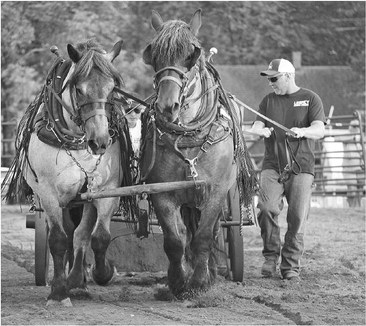
Michael Julian tips the slusher bucket as Jason (middle) and Aaron (left) Julian look on. SASKATOON DAMM/THE STAR NEWS
